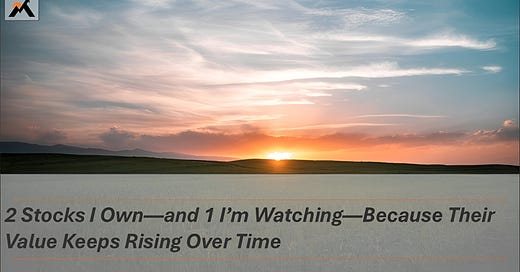2 Stocks I Own—and 1 I'm Watching—Because Their Value Keeps Rising Over Time
Most companies see their forecast period shrink over time. These ones don't, and I already own two of them. The third will be my next Investment Thesis.
In last Tuesday’s post, I broke down how the best businesses manage to keep their competitive advantage period (CAP) intact year after year. These companies defy the powerful pull of mean reversion, where strong returns attract competition, compresses margins, and shortens the runway.
But when disruption risk is low, barriers to entry are high, the moat holds, and reinvestment opportunities are plentiful, something unusual happens: the forecast period doesn’t shrink. As a result, intrinsic value consistently rises.
In this post, I’ll walk through two companies I already own that fit this framework. Then, for premium members, I’ll explore a new high-quality idea I’m actively researching, with the potential for a long, durable CAP.
Amazon
Amazon remains my largest position. Despite its scale, reinvestment opportunities are still strong. The company is on track to spend over $100 billion in capex this year, most of it aimed at AWS and logistics infrastructure. That doesn’t even include R&D investments.
AWS is considered the crown jewel. It dominates cloud computing, benefiting from a first-mover advantage in the 2000s. Barriers to entry are massive: capex, engineering talent, global scale, and a complex ecosystem that creates switching costs. Competitors Microsoft and Google are real, but the cloud market is still early. As Andy Jassy said last quarter:
“It’s useful to remember that more than 85% of the global IT spend is still on premises, so not in the cloud yet. It seems pretty straightforward to me that this equation will flip in the next ten to twenty years.
Before this generation of AI, we thought AWS had the chance to ultimately be a multi hundred billion dollar revenue run rate business. We now think it could be even larger. If you believe your mission is to make customers’ lives easier and better every day, and you believe that every customer experience will be reinvented with AI, you’re gonna invest very aggressively in AI, and that’s what we’re doing.”
Retail is more competitive, but still durable. Amazon controls the entire ecosystem: marketplace, logistics, media, etc. Prime locks in customers, and the fulfillment network is unmatched.
All of this adds up to what should be one of the longest forecast periods in the market. What makes Amazon especially unique is that it’s never stopped reinvesting. It has never optimized for profitability. That constant reinvestment stretches its CAP year after year, thereby raising intrinsic value.
Trying to assign a precise intrinsic value misses the point. When a business keeps adding years to the forecast window, valuation becomes a moving dynamic. And it keeps moving up.
Sanlorenzo
Sanlorenzo is a niche Italian builder of ultra-luxury yachts. It makes up a good chunk of my portfolio. While not a high-growth business, it’s a very predictable business. This is a company where the CAP stays intact.
The industry is relatively small and slow-moving, with little disruption risk. Demand comes from a small—but steadily growing—base of ultra-high-net-worth individuals. These customers demand design, scarcity, and status. In 2024, Sanlorenzo sold just 69 yachts under its core brand, with an average selling price of €11.6 million. Volume is low by design.
This is luxury at the highest tier, above even Ferrari and Hermès. Barriers to entry are extremely high: brand equity, customer trust, and customization are hard to replicate. The company’s moat is reinforced by a tight supplier network and growing vertical integration.
Reinvestment opportunities are in abundance. Sanlorenzo can expand capacity without diluting scarcity by introducing new models, upselling to existing clients, and move horizontally into other niches. It owns Bluegame (sub-24 meter yachts) and has recently acquired Nautor Swan (sailing yachts). That horizontal expansion is something even Ferrari can’t really do.
Thanks to a slow-changing industry with high barriers to entry, one can confidently forecast a long window of high returns on capital.
Premium members get access to the full post, including a third stock I’m actively researching right now. It’s an under-the-radar name with monopolistic assets, new (yet proven) management, and an extremely solid competitive advantage period. It’ll also be the subject of my next Investment Thesis.
To read the full article (and many future articles) consider subscribing for just €105/year (€8.75/month).
This is a limited-time launch offer at 30% off.




